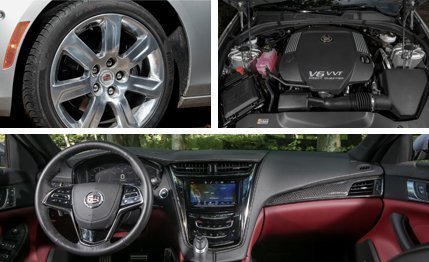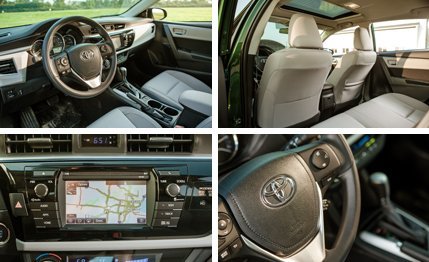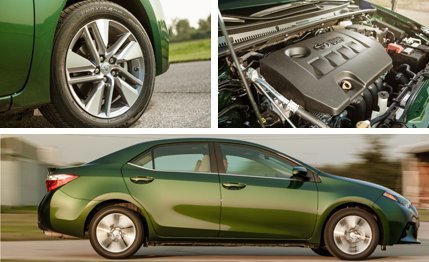
 Instrumented Test
TESTED
Instrumented Test
TESTED
Talk to people who fly commercially in coach class, and they’ll tell you the most precious commodity is legroom. It’s also important to those who prefer a smaller travel tube, and the newly elongated 2014 Toyota Corolla has 41.4 inches of leg space for rear-seat passengers, 4.6 more than in the mid-size Chevy Malibu and even an inch and a half more than in the full-size Impala. Call it coach-plus seating; in terms of space, there are no cheap seats in the new Corolla.
We can’t say the “cheap” descriptor doesn’t apply to other areas of the cabin, though. Toyota spruces up LE-trimmed examples with a padded-vinyl dash panel of contrasting color and piano-black trim bits sprinkled throughout the cabin, and there is real contrasting stitching on the padded door armrests, shifter boot, and seats. But then you notice that the stitching is chintzy faux molded-in stuff on the steering-wheel center and dash and that the door trim mixes hard plastic surfaces and textures that don’t complement one another. Granted, this is a low-priced family compact, but some competitors have managed to imbue some premium-segment magic into their offerings, most notably the redesigned Mazda 3.


Newly optional is a 6.1-inch touch screen that’s bright enough to be of use at high noon, but successfully selecting the tiny screen options while the car is moving takes a steady hand. The navigation display doesn’t offer the greatest detail, and in split-screen mode (as when displaying music selections or nearby roadside attractions), the map shrinks to the size of a smartphone screen held at arm’s length.
Game On
Really, the big news is what Toyota has done to up the Corolla’s fuel-economy game. With its old-school four-speed automatic and 26/34 mpg EPA splits, last year’s LE model was a laggard in the segment. Fast forward to 2014. Despite adding 2.6 inches of length and half an inch in width, the specially equipped LE Eco climbs by 4 mpg city and 8 highway to an EPA-estimated 30/42 rating. That 42-mpg highway number is for a base Eco with 15-inch steel wheels, but the 40-mpg rating affixed to Ecos with the optional 16-inch aluminum wheels of our test car still approaches diesel and gas-hybrid territory.


The Eco model’s special equipment includes low-rolling-resistance tires, underbody aero panels, and a new version of Toyota’s 1.8-liter four with Valvematic continuously variable intake-valve lift and phasing that bumps output by 8 horsepower to 140. All 2014 Corollas can be fitted with a new continuously variable transmission (except the base car, which uses a four-speed auto). But Eco models also get a selectable Eco mode that delivers a lazier calibration at less-than-50-percent throttle—Toyota says it “smoothes acceleration”—and trims A/C compressor operation for more gradual cool-downs. (This is the point where you engage the sweat mode of your body’s natural A/C system.) To ensure one is in Eco mode, you must have both dash Eco lights active; one blazes beneath the gas gauge when you hit the Eco button, and the other comes on under the tach to convey feedback on whether you’ve been naughty with the gas pedal.
There is no tap-shift gate or any steering-wheel paddles in the Eco, although they are available in Corolla S models. Here, the CVT (with a rather conventional 6.3:1 ratio spread) decides what “gear” is the most efficient for the car’s speed and road load, and, like it or not, it’s a key enabler for the Corolla’s big mpg numbers. However, Toyota engineers have seen to it that the engine doesn’t drone on like some homesick sow imitating a dyno pull. At wider throttle openings and higher revs, Toyota has programmed in some artificial steps with up to 750-rpm drops that feel like the gearchanges in a step transmission, although anyone even mildly in tune with the act of driving can see through the ruse. There are two manually selectable ranges, but individual ratios cannot be summoned: S gives an intermediate range with some noticeable engine braking on lift, and B is a low range for even greater engine braking.